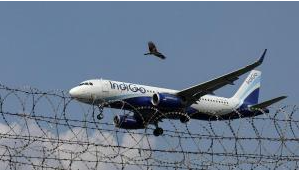1. Introduction
IndiGo Approves India’s largest domestic carrier, , has taken a decisive step in reshaping its fleet financing strategy. The airline’s board has approved a capital infusion of US$ 820 million (approximately ₹7,294 crore) into its wholly owned subsidiary, InterGlobe Aviation Financial Services IFSC, to acquire aircraft assets directly.
This move marks a clear shift away from IndiGo’s traditional dependence on operating leases—especially sale-and-leaseback arrangements—and signals a long-term bet on asset ownership. By owning more aircraft, the airline hopes to insulate itself against foreign exchange risk, reduce leasing costs, and build a more balanced, financially resilient fleet structure.
Here’s a detailed look at what this investment means for IndiGo, its financial strategy, and the broader aviation sector in India.
2. What Exactly Has Been Approved?
-
Investment Amount: US$ 820 million (≈ ₹7,294 crore).
-
Destination: Infusion into IndiGo IFSC, or InterGlobe Aviation Financial Services IFSC Pvt Ltd.
-
Financing Structure: The investment will be made via a mix of equity shares and 0.01% non-cumulative optionally convertible redeemable preference shares (OCRPS) in one or more tranches.
-
Use of Funds: The capital will be used “primarily for acquisition of aviation assets, including aircraft,” underlining IndiGo’s commitment to ownership.
3. Why the Shift Away from Leasing?
3.1 Historical Leasing Strategy
-
IndiGo has long relied on operating leases, often through sale-and-leaseback arrangements.
-
In the sale-and-leaseback model, the airline would sell newly purchased aircraft to lessors, then lease them back, thereby freeing up capital for rapid expansion.
3.2 Risks of the Old Model
-
Foreign exchange risk: Lease payments are typically denominated in US dollars. As the rupee weakens, lease costs in rupee terms balloon, squeezing margins.
-
Mark-to-market accounting volatility: Under operating leases, the value of leased assets must be revalued, which can introduce volatility in financial statements.
-
Lease costs: As lease costs rise (especially in a high-interest, volatile FX environment), the leverage of owning aircraft becomes more attractive.
3.3 Strategic Advantages of Ownership
-
Asset control: Ownership gives IndiGo more control over its fleet and assets, including decisions on maintenance, financing, and deployment.
-
Cost predictability: By owning or using financial leases, IndiGo Approves the airline can mitigate FX risk and stabilize long-term costs.
-
Diversified financing: The IFSC vehicle allows for structured financing options, balancing equity and preference instruments.
-
Tax and regulatory benefits: Routing through GIFT City (IFSC) provides fiscal advantages, potentially lowering the cost of capital
4. IndiGo’s Long-Term Ambition: Fleet Ownership by 2030
IndiGo’s CEO, Pieter Elbers, has laid out a clear vision for the next several years:
-
Target for 2030: The airline aims to have 40% of its fleet either owned or on financial leases, up from about 18% now.
-
IndiGo expects to add more than 250 aircraft by 2030, taking its fleet size to over 600 planes, according to industry estimates.
-
To support this growth, the airline is also planning to set up its own Maintenance, IndiGo Approves Repair & Overhaul (MRO) facility in Bengaluru.
-
This MRO strategy is designed to reduce reliance on third-party maintenance providers, IndiGo Approves lower long-term costs, and integrate maintenance with the aircraft-ownership push.
 FORE MORE INFORMATION
FORE MORE INFORMATION
5. Hedging Foreign Exchange Risk: A Key Driver
A primary motivation behind the capital infusion is to reduce exposure to currency fluctuations:
-
Lease payments are dollar-denominated, which exposes IndiGo to rupee depreciation risk.
-
In its most recent financial results (Q2 FY26), the airline posted a sharp forex loss.
-
By owning aircraft or engaging in financial leases, IndiGo can better manage its cash flows and limit FX-related expenses, since financial leases are treated as an asset and not just a recurring lease liability.
-
Additionally, IndiGo Approves routing these leases through GIFT City IFSC helps because GIFT City is legally treated as a foreign jurisdiction, offering tax advantages and structuring benefits for leasing contracts.
6. Implications for IndiGo’s Financials and Risk Profile
6.1 Impact on Capital Expenditure
-
The ₹7,294 crore injection is a large capital outlay, but it’s being spread across tranches, giving IndiGo flexibility.
-
Over the long run, this could reduce operating lease liabilities, IndiGo Approves free cash flow pressure, and mark-to-market risks.
6.2 Balance Sheet Effects
-
IndiGo IFSC’s net worth, as of March 31, 2025, was ₹413 crore, with a reported turnover and profit, showing that the subsidiary is already operational.
-
The investment will likely increase the asset base of IFSC, IndiGo Approves as aircraft get added on its books.
6.3 Earnings Stability
-
With more aircraft owned or under financial lease, IndiGo Approves can stabilize its lease-related expenses, removing a significant source of volatility in earnings.
-
Over time, this could also improve EBITDAR (earnings before interest, taxes, depreciation, amortisation, and rent) performance, because rent (lease) expense could decline as a percentage of total costs.
6.4 Investor and Stakeholder Confidence
-
This capital infusion reflects long-term commitment to asset-backed growth, IndiGo Approves which may reassure investors concerned about IndiGo’s exposure to leasing risk.
-
It may also improve relationships with lessors and financial institutions, as the company demonstrates a more balanced approach.
7. Risks and Challenges of the Strategy Shift
While the move is strategically sound, there are challenges:
-
Execution Risk
-
Owning aircraft brings additional responsibilities such as maintenance, insurance, and resale risk.
-
IndiGo will need to effectively scale its MRO operations to realize cost benefits.
-
-
Capital Intensity
-
The large capital investment could stress cash flows, IndiGo Approves especially if not carefully phased.
-
There’s risk if aircraft values decline or if there is a downturn in demand.
-
-
Residual and Residual Value Risk
-
When IndiGo owns aircraft, the residual value risk (what the aircraft will be worth at the end) falls on it.
-
-
Regulatory Risk
-
While GIFT City provides benefits, regulations around leasing, accounting, IndiGo Approves and international finance could change.
-
-
Market Risk
-
If demand slows or fuel costs rise, the cost-benefit trade-off of owning vs leasing could shift again.
-
Global interest rate changes could impact the cost of capital for financing these aircraft.
-
8. Strategic Context: Why Now?
Several recent developments make this a timely decision by IndiGo:
-
Rupee volatility: As seen in its recent earnings, IndiGo Approves forex losses are a real pain point.
-
Grounded aircraft: IndiGo has faced grounding of aircraft (for example, due to engine issues), and returning these to service increases the need for stable fleet planning
-
Regulatory shifts: With India proposing to ease aircraft-leasing norms, the rules might become more favourable for hybrid ownership models.
-
Fleet growth ambitions: With a target of 600+ aircraft by 2030, IndiGo needs a robust and scalable financing model.
-
MRO capability: The planned MRO in Bengaluru is not just a cost lever but a critical enabler for owning more aircraft.
9. Broader Implications for the Indian Aviation Industry
IndiGo’s move could have ripple effects across the industry:
-
Private aviation financing: Other Indian carriers may also consider boosting their ownership or financial-lease exposure to reduce forex risk.
-
Lessors in India: Lessors may need to compete more aggressively or offer more attractive financing terms as airlines lean toward ownership.
-
Growth of IFSC leasing vehicles: IndiGo’s IFSC subsidiary may set a template for how other airlines use GIFT City to structure aircraft financing.
-
MRO ecosystem: As more airlines own aircraft, IndiGo Approves demand for domestic MRO capacity will increase, supporting ancillary industry growth.
-
Risk management: Airlines may hedge currency risk more proactively, incorporate asset ownership strategies, and focus more on long-term balance sheet strength.
 FORE MORE INFORMATION
FORE MORE INFORMATION
10. Commentary from Leadership
IndiGo’s CEO, Pieter Elbers, has been vocal about this strategic pivot:
-
He has openly acknowledged a return to financial lease and direct ownership, moving away from the earlier sale-and-leaseback model.
-
Elbers emphasized that by 2030, a meaningful portion of the fleet will be owned or on financial leases (around 40%).
-
On valuation benefits, he pointed to GIFT City as a cornerstone for optimizing lease financing, providing tax efficiency and structuring flexibilities.
-
He also noted that an in-house MRO facility is essential to unlocking long-term cost efficiencies and controlling maintenance risks.
11. Investor and Market Reaction
While real-time market reaction may evolve, some early observations include:
-
The investment underscores IndiGo’s long-term vision, which may appeal to long-term investors who prioritize balance sheet strength and disciplined capital deployment.
-
Analysts are likely to view the move as a hedge against future leasing volatility, IndiGo Approves especially in currency and lease-rate risk.
-
However, the large size of the investment could raise questions about cash deployment and return on capital, especially if not managed in phases.
12. Strategic Risks and External Threats
Beyond the internal challenges, IndiGo’s strategy must contend with:
-
Competition from other airlines: Legacy carriers and low-cost rivals may respond aggressively.
-
Macroeconomic conditions: A downturn in passenger demand or rise in interest rates could stress capital-intensive strategies.
-
Technological disruption: With new aircraft models (including more efficient jets) coming in, value of older aircraft may depreciate faster.
-
Regulatory uncertainty: Aviation policies, tax regimes, and IFSC regulations could change, affecting the economics of ownership vs lease decisions.
13. The Bigger Picture: Resilience and Self-Reliance
IndiGo’s capital infusion into its IFSC arm is more than just a financial maneuver. It reflects a broader ambition: resilience and self-reliance.
-
By owning aircraft ,IndiGo Approves reduces dependence on external lessors and volatile lease markets.
-
The move builds a long-term asset base, making the airline more robust against shocks.
-
The GIFT City vehicle suggests a push toward innovative financial structuring, IndiGo Approves which can optimize tax, regulatory, and financing outcomes.
-
MRO investments further enhance self-reliance, enabling IndiGo to service and maintain its owned fleet with greater autonomy.
14. Key Takeaways
-
Strategic Shift: IndiGo Approves is moving from leasing-heavy to more ownership/financial lease structure.
-
Massive Investment: ₹7,294 crore (US$820 million) is being deployed via its GIFT City subsidiary.
-
Rationale: To reduce forex exposure, stabilize lease costs, and build long-term value.
-
Fleet Vision: By 2030, 40% of its fleet targeted as owned or financial lease.
-
Support Structure: New MRO facility in Bengaluru and use of GIFT City for financing.
-
Risks: Capital intensity, execution, asset value risk, regulatory shifts.
-
Implications: Could reshape Indian airline financing and MRO industry.
15. Conclusion
IndiGo’s approval of more than ₹7,000 crore investment into its IFSC subsidiary marks a watershed moment in its 19-year journey. The airline’s historic reliance on operating leases is giving way to a balanced model of asset ownership and financial lease that promises cost stability, reduced currency risk, and more control over its fleet.
While the strategic bet is bold, its success will depend on disciplined execution, scaling of maintenance infrastructure, and careful financial planning. If done right, IndiGo Approves this move could strengthen IndiGo’s competitive moats, make its growth more sustainable, and shield it from volatile external pressures.
In an industry where scale, capital intensity, and risk management are everything, IndiGo’s big bet may well pay off — positioning it not just as India’s largest airline but one of its most self-reliant and financially resilient. ALSO READ:-IMD Issues Cyclone Alert Over Bay of Bengal: Heavy Rainfall Forecast for Andaman and Nicobar Islands 2025





